The best enduro mountain bike helmets finely balance protection and breathability to ensure you don't get too sweaty on the way to the next stage.
Enduro mountain bike helmets often come in a full-face or convertible full-face style, with the latter enabling you to remove the chin bar of the helmet, turning it into an open-face helmet for added breathability on the ascents.
While looking very similar to downhill helmets, enduro helmets are often lighter and more airy, enabling them to be worn out on the trails.
To race enduro, many organisers will require you to wear a helmet that's in accordance with the ASTM F-1952 DH racing safety standard.
As ever, we’ve taken all of these factors into consideration in a bid to make your buying decision that bit easier.
We've included our enduro helmets buyer's guide at the bottom of the page, so be sure to check that out before your next purchase.
Editor's note: This list was updated on 3 January 2025.
Best enduro mountain bike helmets
Bell Super DH MIPS
SQUIRREL_TEXT_13108368
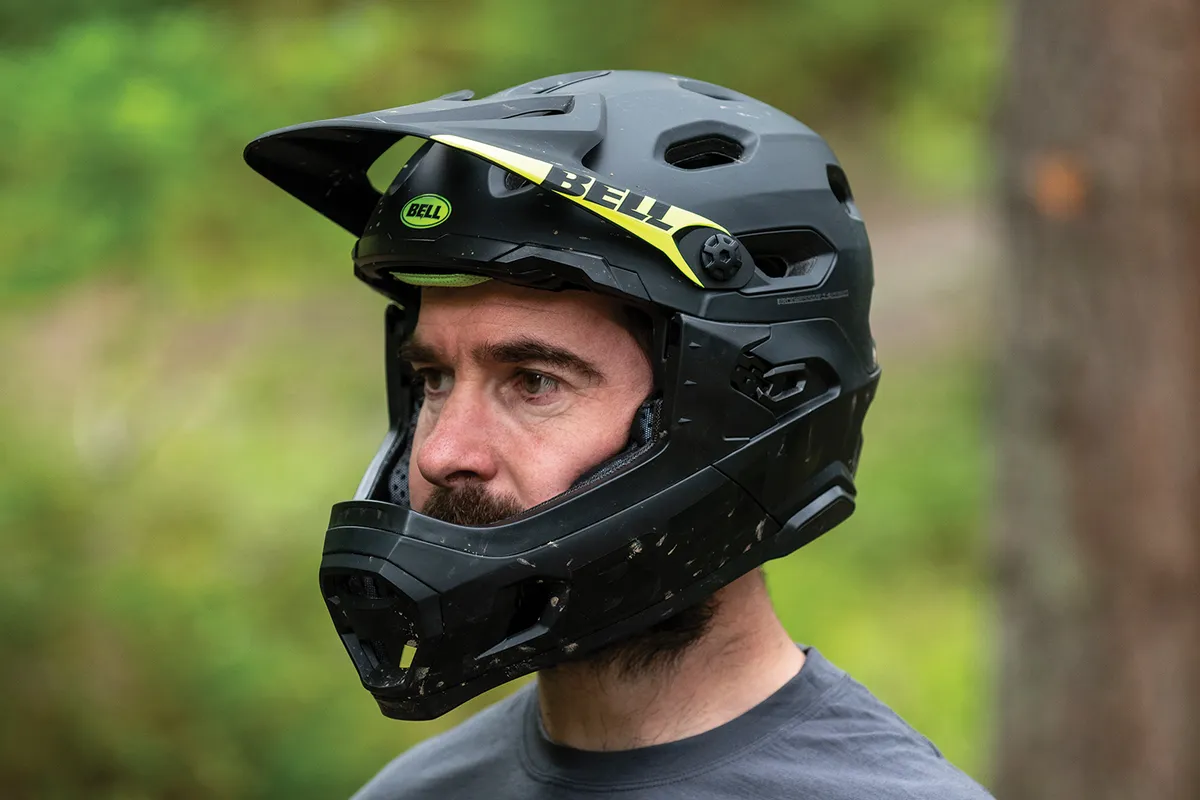
- £319.99 as tested
- Pros: Comfortable with good venting; open-face mode feels secure
- Cons: Chinbar could be easier to fit
Bell’s Super DH feels like a full-on downhill full-face (although it’s not quite as solid-feeling as the Giro Switchblade), with firm, rather than plush, padding.
Unlike the brand’s cheaper Super 3R convertible lid, it’s DH-certified and uses the latest MIPS Spherical brain-protecting technology. It’s comfortable on your head, and venting in its full-face configuration isn’t too bad at all.
The chin bar is light and shallow enough to be clipped onto a pack without any drama. Fixing it onto the open-face lid is easy enough and the three locking clasps give a reassuringly positive ‘snap’ once they’re closed properly.
It’s worth whipping the Super DH off your head to fit the chin bar though, because it’s a little fiddly.
In open-face mode, the Bell helmet offers a head-hugging fit, with a brim that drops low around the ears and covers your temples.
The retention cradle tightens evenly, and we had no comfort issues when wearing it as an open-face lid on longer, sweaty rides. While it’s by no means the lightest helmet, it feels stable and its weight is distributed well.

It's not quite perfect though. The thin strap can tangle quite easily, which makes lining up the Fidlock buckle tricky if you’re wearing a pair of the best mountain bike gloves or have cold hands.
It also sits quite close to your neck, so we’d like to see a bit of extra padding to boost comfort further.
SQUIRREL_13108368
Giro Switchblade MIPS
SQUIRREL_TEXT_13082527
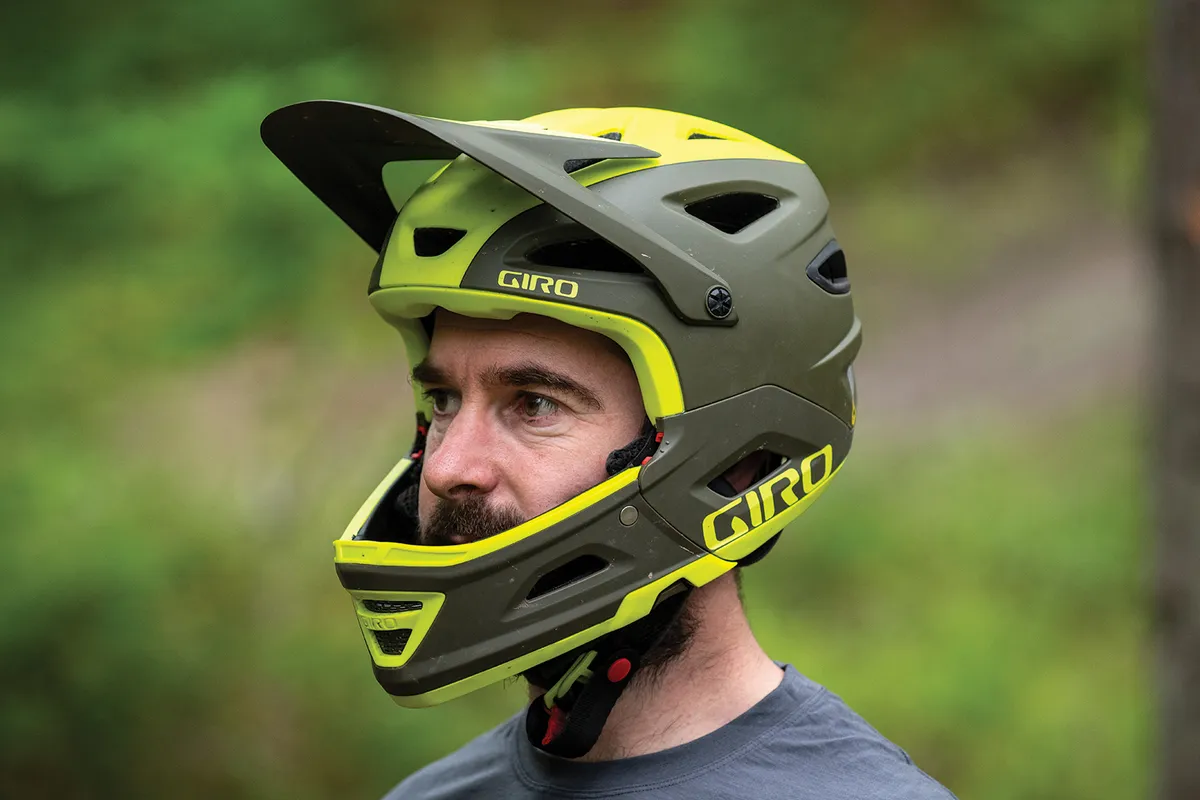
- £274.99 / $279.95 as tested
- Pros: Robust, confident feel; impressive comfort
- Cons: Not the most breathable in full-face mode
Giro's Switchblade MIPS feels more like a regular full-face compared to other convertible helmets, and is one of the comfiest.
The snug fit makes for a confident feel and, with the large adjuster dial cinched up, we had no issues with it moving around on really rough trails. In open-face mode, it has the most head coverage, which, coupled with the MIPS liner, should keep you well protected.
We’re big fans of the double D-ring closure and padded strap, which is slower to use but very secure and less fiddly than some of the Fidlock-equipped lids here, which have thin straps that twist easily. It also means it’s really comfortable (if a little sweaty) once done up.
One of the big plus points with the Switchblade is the size of the chin bar. It’s smaller than many rival helmets, which means carrying it is easy and it’ll fit inside a pack.
Attaching it is simple enough too (and doable when on your head), just requiring accurate alignment of the metal lugs before clicking it down into place. It’s a plus that Giro includes more padding and a spare peak.
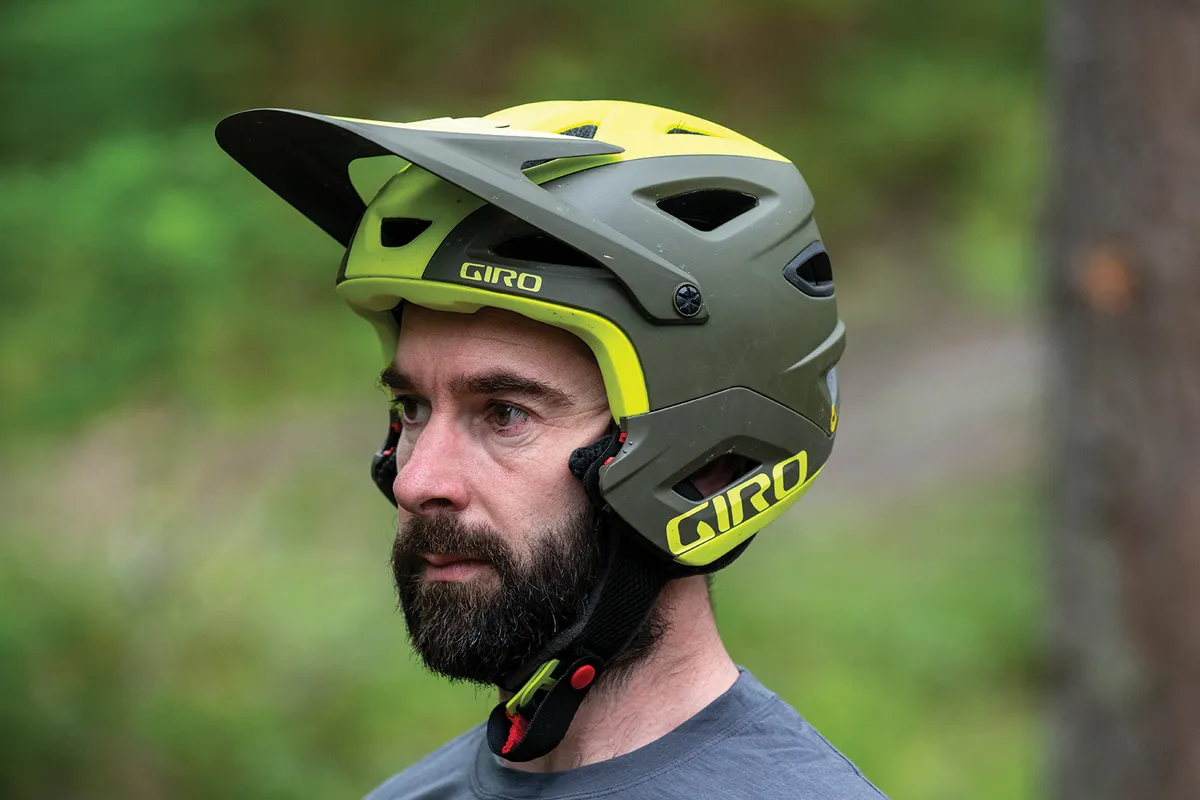
The downsides? All that open-face helmet coverage adds to the weight and it got quite sweaty during testing. Some testers noted the big adjuster wheel could be felt at the base of the neck at extreme angles, and we’d like a more positive click from the chin bar on engagement.
SQUIRREL_13082527
Smith Mainline
SQUIRREL_TEXT_13076499

- £275 / $300 / €300 as tested
- Pros: Good air-flow; plenty of safety features; secure design
- Cons: Not the lightest, but this doesn't detract from overall comfort
The Mainline from Smith is downhill-certified and can be used for multiple disciplines, which makes its high price tag look more appealing.
There's a MIPS liner inside, which is claimed to help protect your brain from angular impacts. It's available in three sizes and you get three different-size pad sets bundled in to ensure a secure fit.
It's an ideal choice for those looking for some extra protection while trail riding or enduro racing.
There's a D-ring closure, which takes a little longer to fasten than magnetic designs, but the padded strap means it's really comfortable.
Open vents around the chin mean the Mainline never feels claustrophobic when you’re breathing hard, and on cooler days we didn't bother removing it for the climbs.
Its Achilles heel is its weight – 830g for a size medium, not that it detracts from the comfort.
SQUIRREL_13076499
Specialized Gambit
SQUIRREL_TEXT_13115262

- £295 / $300 / €350 / AU$480 as tested
- Pros: Comfortable and airy feel; fully certified; lightweight
- Cons: Pricey; cheek pad mounts aren't the most robust
Specialized's Gambit features a carbon fibre construction that is fully ASTM downhill-certified.
This construction sees a medium-sized helmet weighing in at 627g, which is seriously light for a full-face design.
The helmet features plenty of adjustability, which our tester found resulted in an incredibly comfortable fit.
Large vents at the front allow plenty of air intake, and cleverly designed exhausts on the rear allow warm air to escape.
We did have trouble with the cheek pad mounts, which were tricky to clip the pad into and would sometimes work loose, though this subsided after some use.
SQUIRREL_13115262
Leatt MTB 4.0 Enduro V21
SQUIRREL_TEXT_13122794
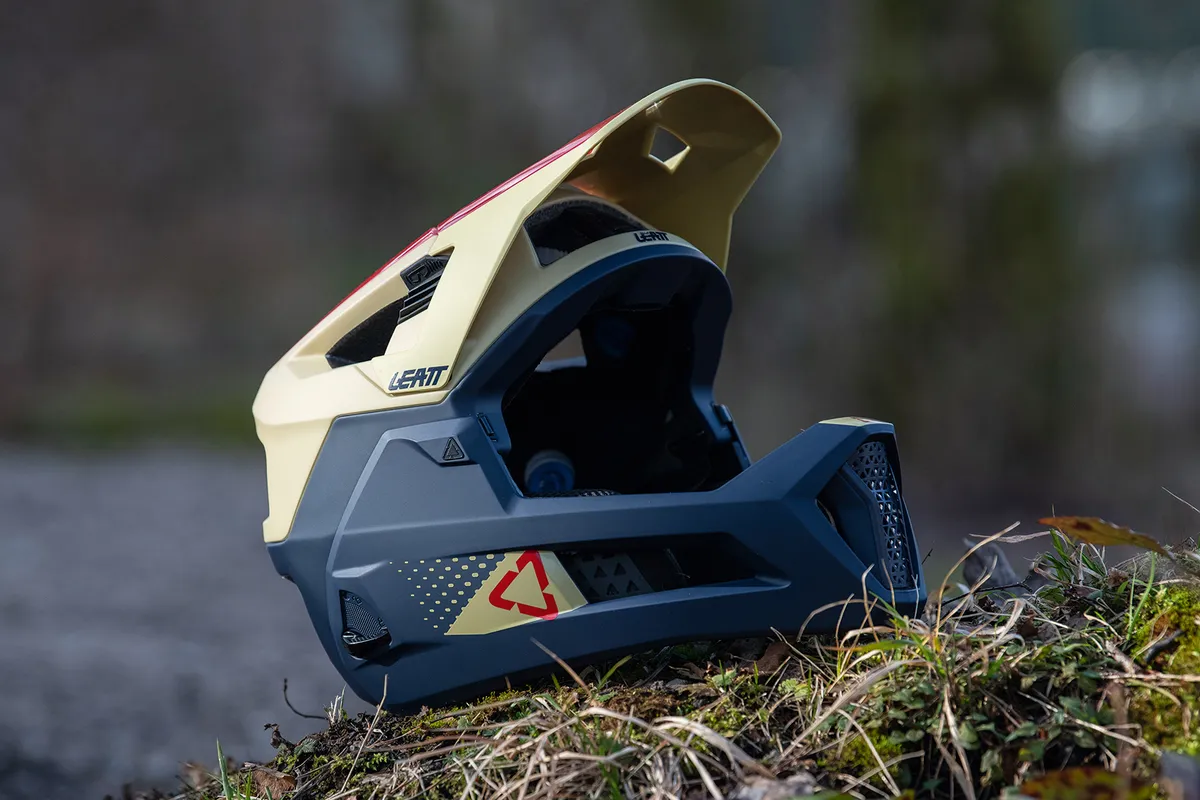
- £280 / $300 / €331 as tested
- Pros: Well-priced; good ventilation; plenty of features
- Cons: Slight ear rub on long rides; attaching chin bar could be slicker
Leatt's convertible helmet packs in lots of features. There's good coverage around the back of the skull with the deep design, and the chin bar comes with additional pads to ensure an optimal fit.
The brand uses 360 Turbine Technology in place of MIPS, which is said to provide both anti-rotational protection and helps to absorb straight-on impacts. We found the comfortable pads and fairly neutral shape that houses the system to fit snugly.
A Fidlock magnetic buckle and fixed webbing straps secure the helmet to your head. You can store your mountain bike goggles underneath the three-position peak or your sunglasses behind the peak in the rubber dock.
We were particularly impressed by the ventilation, with plenty of big vents in the top half of the helmet.
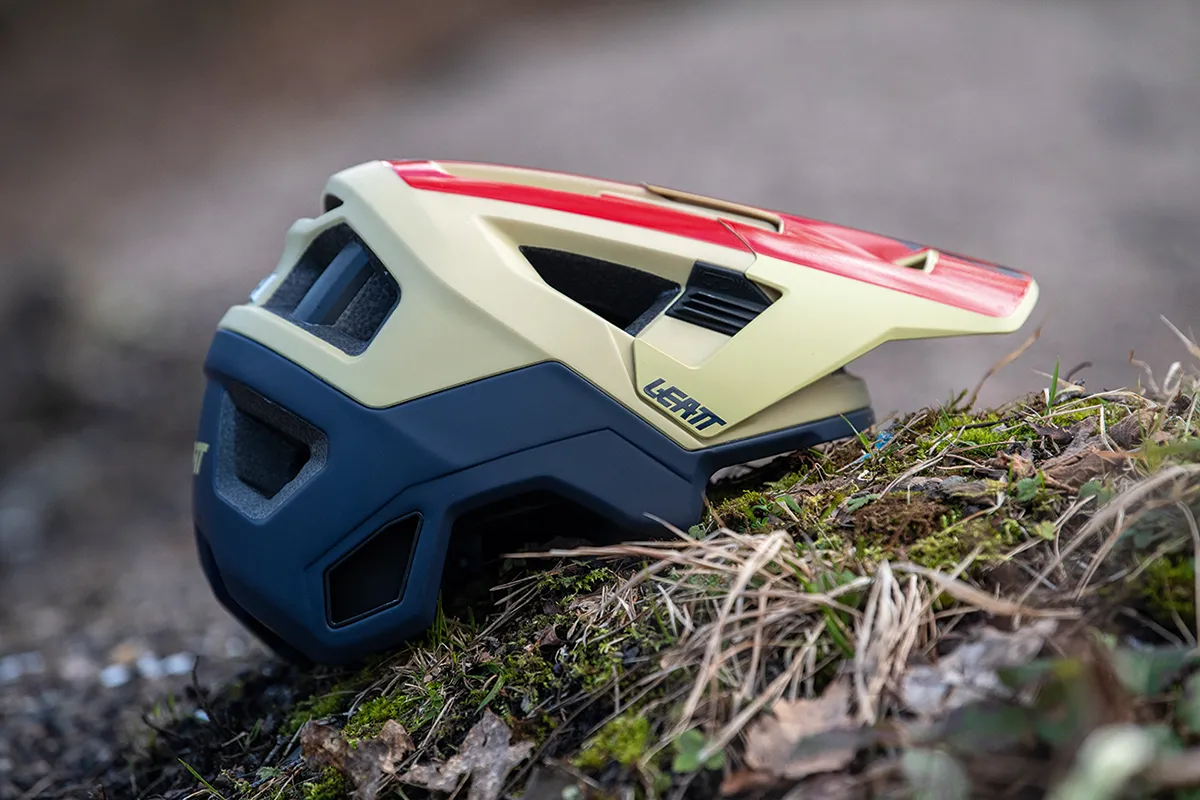
The downsides are we found the height-adjustable cradle that pulls on a band secured at the temples dug into our ears. The helmet is also a little heavy at 850g in full-face mode for our size-medium helmet, or 501g in its half-shell guise.
SQUIRREL_13122794
MET Parachute MCR
SQUIRREL_TEXT_13076453

- £300 as tested
- Pros: Solid and secure feel; chin bar can be installed with the helmet on
- Cons: Helmet needs to be fully loosened off to be removed
MET was one of the first brands to bring out a convertible helmet, with the original Parachute, but the new MCR (Magnetic Chin bar Release system) is a big departure from its previous lids.
It looks far chunkier and more solid than the last convertible iteration, which many will appreciate – along with the inclusion of a MIPS liner and an easy-to-remove/replace chin bar.
In its open-face configuration, the Parachute vents reasonably well, offers a decent level of coverage and, thanks to the finely indexed Boa dial that adjusts the retention cradle, delivers a well-tensioned and really comfortable fit.
Attaching the chin bar is quick and hassle-free – unlike many rival helmets, we could remove or replace it without taking the whole helmet off (just about).
As a full-face, the Parachute feels solid, stable and really comfortable. While it’s not the coolest, airflow isn’t too bad. We like the long peak, which is really flexible and thus less likely to snap in transit.

There’s unfortunately no getting around the fact that you need to loosen the Boa dial completely before taking the helmet off or putting it back on, which is its main disadvantage. If you don’t do so, it’s a bit of an uncomfortable squeeze to get your head past the retention cradle.
SQUIRREL_13076453
Also consider…
Sweet Protection Arbitrator
SQUIRREL_TEXT_13076457
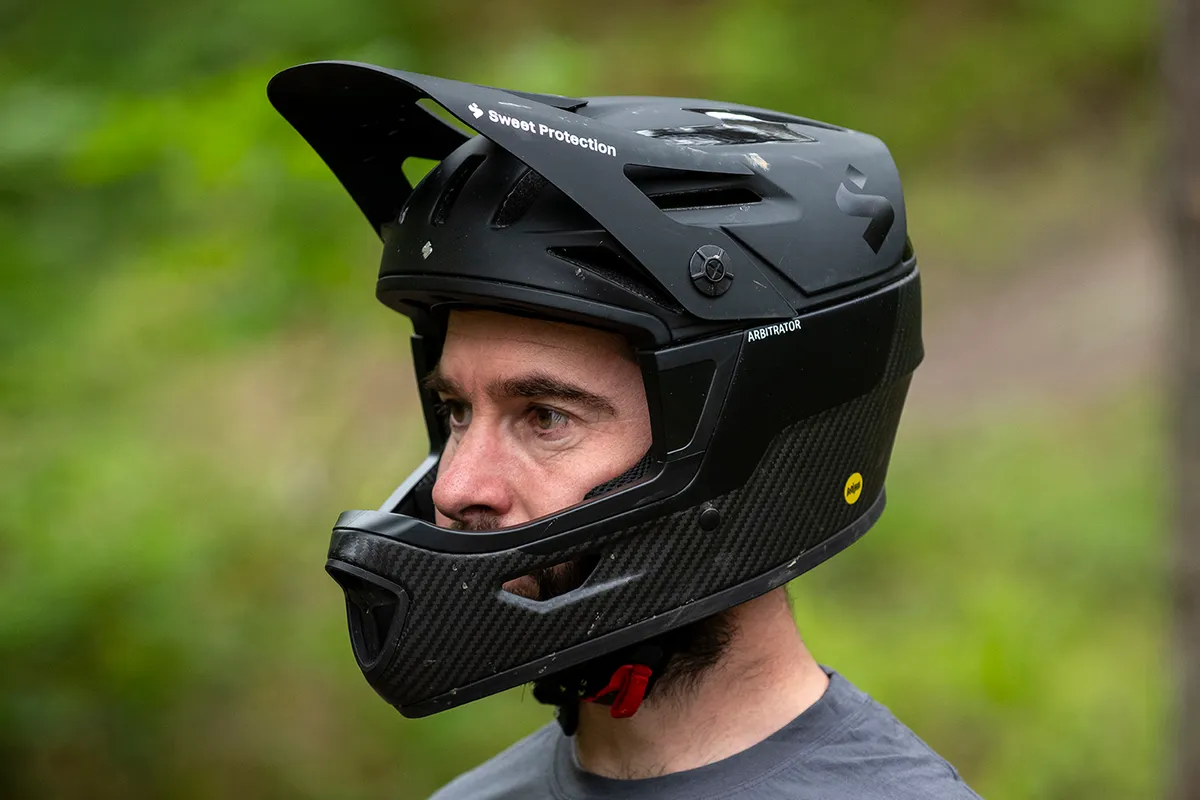
- £309.00 as tested
- Pros: Full-face feels uncompromised; comfortable for long rides
- Cons: Weight is noticeable in half-face mode; not the easiest to convert
Sweet Protection hasn’t economised on safety or protection with the Arbitrator. Its quality and sturdiness make this one of the most solid-feeling helmets on test – you wouldn’t know it was a convertible lid in a blind test.
The ratchet-style closure on the chin bar is easy to release, and comfier than the Fidlock magnetic buckle on the Leatt, MET and Bell helmets in this list. There are separate straps to use in open-face mode, which can be tucked away.
The carbon chin bar attaches using lugs, locater tabs and a clip that can be locked in place once fixed on. While the connecting clip is stiff, it’s solid once clamped in. Sweet Protection includes a MIPS liner to protect against rotational impacts.
Venting across the brow is decent enough, although it still gets pretty sweaty when you’re working hard, even in the open-face configuration.
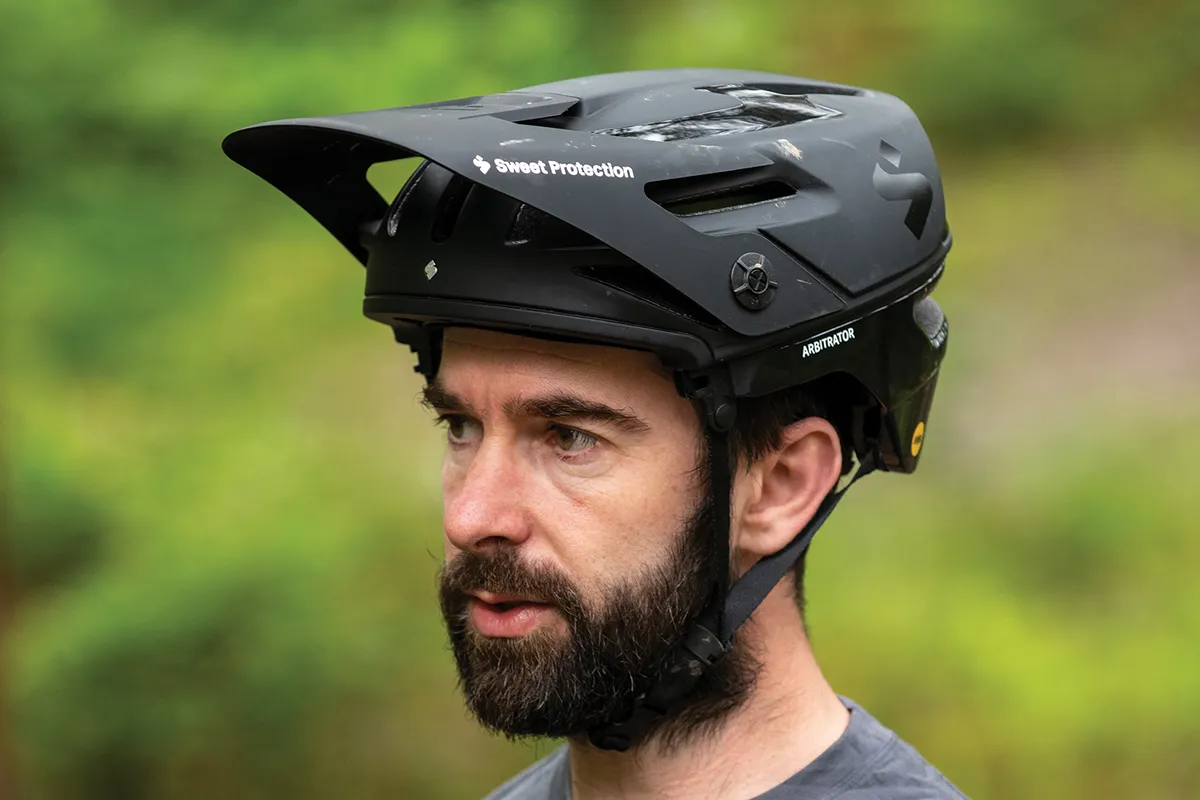
What's not so good? While the overall weight didn’t bother us in full-face mode, without the chin bar you really notice it.
We found we had to crank up the retention cradle to keep it secure when tackling rough trail sections. The vertical adjustment on the retention cradle can shift accidentally sometimes too.
The stiff locking clip at the rear takes some thumb strength to secure early on when reattaching the chin bar, although Sweet Protection assures us this gets easier the more you do it. Once removed, the chin bar is the bulkiest to carry.
SQUIRREL_13076457
How we test enduro helmets
We test enduro helmets in their natural habitat, winching up steep fireroad climbs and bombing down descents. Our testers spend long durations in the helmets to identify any strengths or weaknesses in their design.
Ultimately, our enduro helmet reviews are based on the following criteria:
- Comfort: is the helmet comfy for long durations of trail riding?
- Protection: does the helmet feature sufficient safety features such as MIPS or similar?
- Features: is the helmet equipped with any special features?
- Weight: does the helmet's weight affect its performance?
- Value for money: are you getting a good deal compared to other helmets on the market?
Why you can trust BikeRadar
BikeRadar has been an authority on bikes and cycling tech since its inception in 2007, delivering the world’s best riding advice.
We have experts testing all types of bikes, parts, clothing and accessories, from road, mountain and gravel bikes to commuting, bikepacking and electric bikes.
Our reviews are always editorially independent – with no exceptions. Our reviewers comprehensively test all products in the real world, always reflecting on performance, value and the wider market when delivering their verdicts and review ratings.
We have more than 15,000 product reviews available at your fingertips, as well as expert buying, maintenance, training, skills, health and fitness advice.
Our annual Bike of the Year test is an industry benchmark and the BikeRadar team consists of some of the most experienced riders and testers in the business.
Enduro helmets buyer's guide
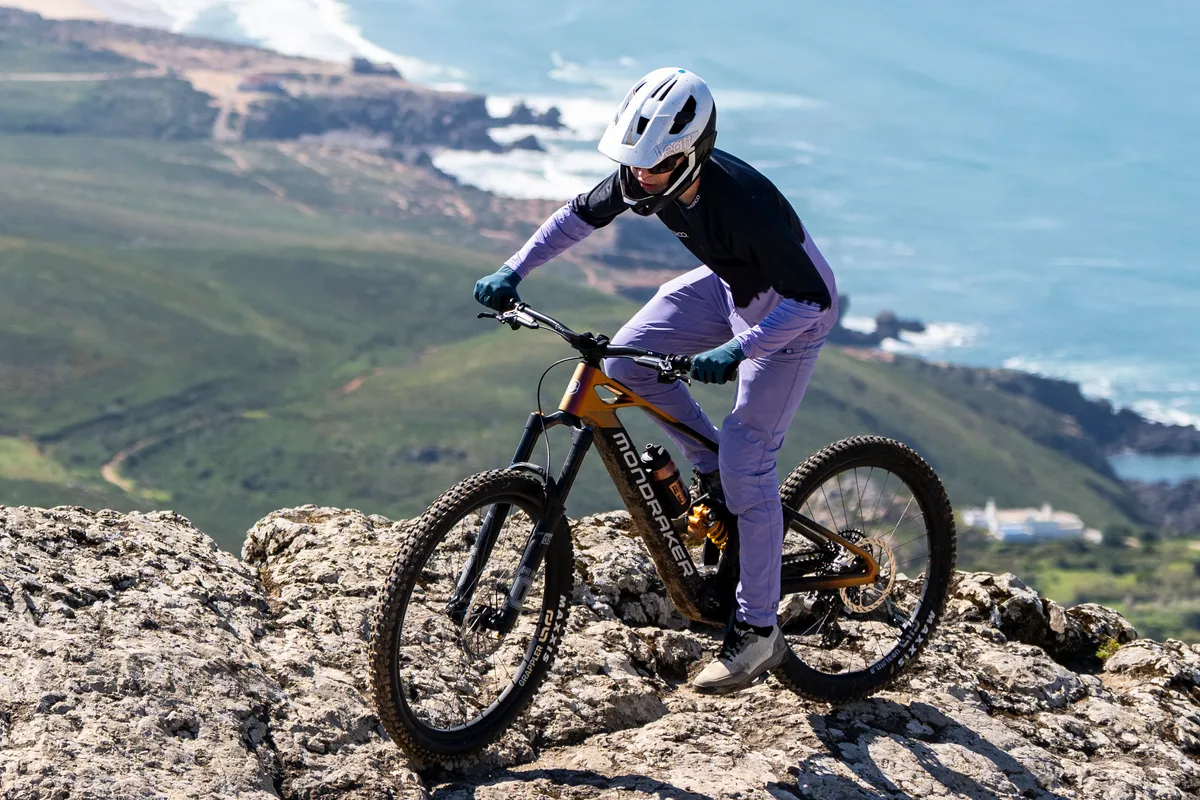
Enduro helmets offer protection levels similar to downhill helmets, but have to be lighter and vent more air to make them useable on the trails.
This has seen two markedly different styles emerge, with some helmets featuring a convertible design that enables you to effectively wear a half-face on the climbs.
Other designs feature rigid constructions that emphasise large vents for keeping you cool on the hills.
Convertible helmets
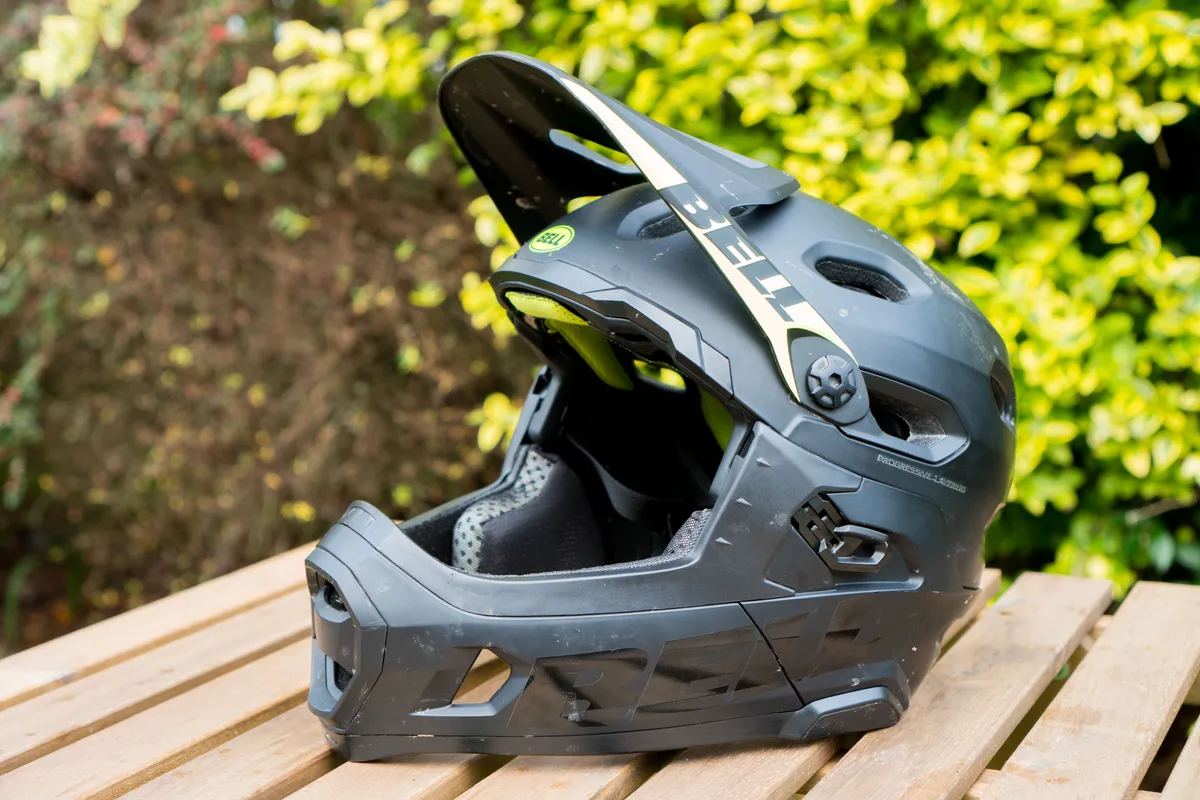
Convertible mountain bike helmets offer versatility on the trail with the protection of a full-face and the ventilation of an open-face lid in one package, so you're essentially getting two helmets for the price of one.
While a full-face offers better protection for the downs, there’s no way you’d want one on the ups. So, pedal up the hill in open-face mode before clipping the removable chin bar on so you’re better protected as gravity takes over.
As with anything designed to be two things in one, there’s always going to be a degree of compromise. Convertible enduro helmets tend to be a little heavier in open-face guise than a regular trail lid because they need extra structural elements to ensure they can be turned safely into a full-face helmet.
When they’re in their descending configuration, they don’t always feel as solid or robust as a full-on downhill lid, even though most convertible helmets (including all those tested here) meet the ASTM F-1952 DH racing safety standard.
Finally, don’t forget, when the helmet’s not in full-face mode, you need to carry the chin bar somehow.
Full-face helmets

Full-face helmets offer more protection than convertible helmets, with their rigid nature enabling them to be built stronger and lighter.
The downside is you don't get the relief of an open-face on the way up the trail, although many brands try to provide increased ventilation compared to their downhill full-face helmets.




